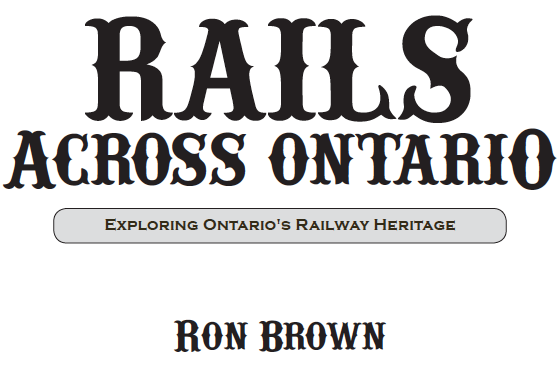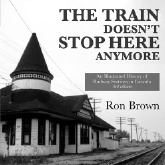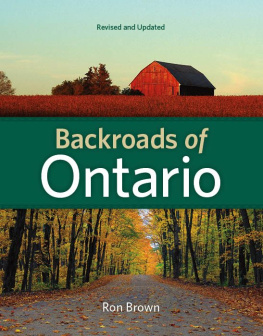Ron Brown - Rails Across Ontario
Here you can read online Ron Brown - Rails Across Ontario full text of the book (entire story) in english for free. Download pdf and epub, get meaning, cover and reviews about this ebook. year: 2013, publisher: Dundurn, genre: Detective and thriller. Description of the work, (preface) as well as reviews are available. Best literature library LitArk.com created for fans of good reading and offers a wide selection of genres:
Romance novel
Science fiction
Adventure
Detective
Science
History
Home and family
Prose
Art
Politics
Computer
Non-fiction
Religion
Business
Children
Humor
Choose a favorite category and find really read worthwhile books. Enjoy immersion in the world of imagination, feel the emotions of the characters or learn something new for yourself, make an fascinating discovery.

- Book:Rails Across Ontario
- Author:
- Publisher:Dundurn
- Genre:
- Year:2013
- Rating:4 / 5
- Favourites:Add to favourites
- Your mark:
- 80
- 1
- 2
- 3
- 4
- 5
Rails Across Ontario: summary, description and annotation
We offer to read an annotation, description, summary or preface (depends on what the author of the book "Rails Across Ontario" wrote himself). If you haven't found the necessary information about the book — write in the comments, we will try to find it.
Rails Across Ontario — read online for free the complete book (whole text) full work
Below is the text of the book, divided by pages. System saving the place of the last page read, allows you to conveniently read the book "Rails Across Ontario" online for free, without having to search again every time where you left off. Put a bookmark, and you can go to the page where you finished reading at any time.
Font size:
Interval:
Bookmark:


Copyright Ron Brown, 2013
All rights reserved. No part of this publication may be reproduced, stored in a retrieval system, or transmitted in any form or by any means, electronic, mechanical, photocopying, recording, or otherwise (except for brief passages for purposes of review) without the prior permission of Dundurn Press. Permission to photocopy should be requested from Access Copyright.
All photos courtesy of the author unless otherwise noted.
Editor: Britanie Wilson
Design: Jesse Hooper
Epub Design: Carmen Giraudy
Library and Archives Canada Cataloguing in Publication
Brown, Ron, 1945-, author
Rails across Ontario : exploring Ontarios railway heritage / Ron Brown.
Includes bibliographical references and index.
Issued in print and electronic formats.
ISBN 978-1-4597-0753-5 (pbk.).--ISBN 978-1-4597-0754-2 (pdf).--ISBN 978-1-4597-0755-9 (epub)
1. Railroads--Ontario--History. I. Title.
TF27.O6B76 2013 385.09713 C2013-904120-6
C2013-904121-4

We acknowledge the support of the Canada Council for the Arts and the Ontario Arts Council for our publishing program. We also acknowledge the financial support of the Government of Canada through the Canada Book Fund and Livres Canada Books, and the Government of Ontario through the Ontario Book Publishing Tax Credit and the Ontario Media Development Corporation.
Care has been taken to trace the ownership of copyright material used in this book. The author and the publisher welcome any information enabling them to rectify any references or credits in subsequent editions.
J. Kirk Howard, President
Visit us at: Dundurn.com
Pinterest.com/dundurnpress
@dundurnpress
Facebook.com/dundurnpress

R esearch for this work involved the cooperation and support of many individuals. Among them are Michael Morrow of CN Rail in Sault Ste. Marie, for his time and informative tour of the railways unusual roundhouse; Cody Cuccitti, curator of the Northern Ontario Railroad Museum and Heritage Centre in Capreol, for his insightful tour of the museums fine collection; and Deneen Perrin, public relations director of the Fairmont Chteau Laurier in Ottawa, for an inside look at its historic property. Juris Zvidris of the Canadian Railway Historical Association, Toronto and York Division, shared with the author the favourite train-watching spots enjoyed by his fellow members. Conductors and crew of the Ontario Northland Railways fabled Northlander train shared much knowledge about the sights along that historic train route (as well about the politics of the trains cancellation). Clare and Richard Smirden deserve much credit for their considerable efforts to save and preserve one of the norths finest railway stations, that in Temagami. I would also like to thank Carol Caputo of Algoma Country Tourism, as well as Sudbury Tourism, and Dr. Lynn Pratt of Thunder Bay for their hospitality. I want to acknowledge the important contribution of Mr. George Bryant, who led me to the railway rock etchings beside the tracks near Gravenhurst, and in particular for the research that he submitted. And none of my books would be possible without the patience of my wife, June, through my many and sometimes prolonged absences to travel the length and breadth of this large province in an effort to track the stories of its railway heritage.
Ron Brown, Toronto, January 2013
THE RAILS ARRIVE:
The Growth of Ontarios Rail Network
P rior to 1830, travel around what is now Ontario was slow and arduous. Roads, where any existed, were rutted quagmires for much of the year. Stage travel between Montreal and York (now Toronto) could last up to five days. Canals were dug to ease the shipping of produce, but these were restricted to navigable waterways and were seasonal. It was little wonder that the 1830s saw concerted talk of railways.
Trains were up and running in both England and the United States by the 1830s. Canadas first railway was that which, in 1832, linked La Prairie on the St. Lawrence River and St. Jean on the Richelieu an 18-kilometre year-round route that eliminated what previously was a 120-kilometre journey over water and land. Ontarios first was a horse-drawn portage railway which bypassed the falls and rapids of the Niagara River by connecting Queenston with Chippawa, located above the mighty cataract.
Nearly two decades would pass before Ontario witnessed its first steam train, one that began at a small wooden station on Lake Ontario and made its way to Machells Corners (later Aurora) in 1853. This was the Ontario, Simcoe, and Huron Railway.
Following that it was open season. New laws such as the Railway Guarantee Act of 1849, the Municipal Corporations Act, and the Mainline Railway Act, also passed in 1849, helped guarantee loans and empowered municipalities to raise money to finance the building of new lines. Within five years construction was under way on the Great Western Railway, an American line linking New York State with Michigan; the Grand Trunk (GT), which would open a line from Montreal through Toronto and on to Sarnia; and the Buffalo, Brantford, and Goderich (later the Erie and Huron) line, which would connect Lake Erie with Lake Huron. The Brockville and Ottawa and the Cobourg and Peterborough Railways also began operating at this time.
Expansion ground to a halt during the American Civil War, but started again in earnest following Confederation in Canada in 1867. By 1910 more than 115 railway charters had been granted in Ontario alone, and the province was nearing a railway saturation point.
With the growth in towns and cities, and more particularly in profitability, rail lines began amalgamating. By 1890 the Grand Trunk had absorbed the Great Western and the Midland Railways and was quickly gobbling up the many resource and branch lines that were responsible for a spiders web of tracks across southern Ontario.
The Canadian Pacific Railway (CPR) was a relative late-comer to southern Ontarios railway landscape. In 1872, the Toronto, Grey and Bruce (later the CPR) began laying tracks that would ultimately connect Owen Sound with Union Station in Toronto. It operated from a terminus at Queens Quay (near the foot of todays Bathurst Street), through Orangeville, to Owen Sound and Teeswater. It was operating by 1873 and became part of the Canadian Pacific Railway (CPR) a decade later.
Another line that was to become part of the CPR was the Credit Valley Railway (CVR), which began running from Parkdale in Toronto to St. Thomas in 1881, with additional branches to Orangeville and Elora.
The 1880s also saw the CPR add to its network the Ontario and Quebec Railway, which would stretch from Montreal through Smiths Falls, Peterborough, and West Toronto Junction. It had originally shared a junction in Perth with the earlier Brockville and Ottawa line. Following the completion of the CPRs Lakeshore line, its yard facilities were relocated to Smiths Falls and all evidence of the yards and buildings in Perth were long gone. In 1883 the Ontario and Quebec (O&Q) acquired the CVR, both of which became part of the CPR the following year.
Font size:
Interval:
Bookmark:
Similar books «Rails Across Ontario»
Look at similar books to Rails Across Ontario. We have selected literature similar in name and meaning in the hope of providing readers with more options to find new, interesting, not yet read works.
Discussion, reviews of the book Rails Across Ontario and just readers' own opinions. Leave your comments, write what you think about the work, its meaning or the main characters. Specify what exactly you liked and what you didn't like, and why you think so.









